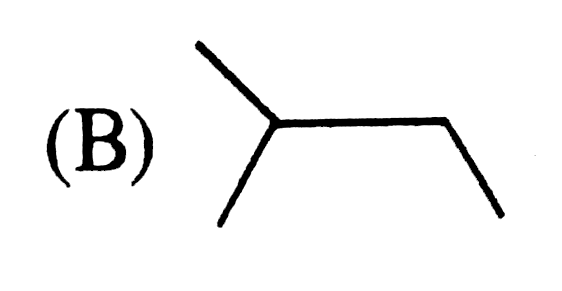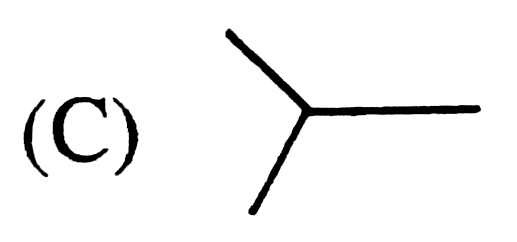An ethereal solution of an alkyl halide preferably the bromide of iodide, is treated with sodium
2R−X+2NaEther−−→R−R+2NaX
2CH3−Br+2NaEther−−→CH3−CH3+2NaBr
CH3CH2Br+2Na+CH3BrEther−−→CH3CH2−CH3+2NaBr
In this reaction, the product has new (C-C) bond with the same type of alkyl halide, the product has symmetery and this helps in deciding the nature of reacting halide. Intermediates are free radicals
Formation of free radical is easiest in
CH3CH2Cl
CH3CH2Br
CH3CH2F
CH3CH2I
The correct Answer is:D
Bonds energy of C-I is the lowest (among C-X bonds)
Topper's Solved these Questions
Similar Questions
CH3Br−CH2−O∣∣C−CH2CH3
View SolutionAn ethereal solution of an alkyl halide preferably the bromide of iodide, is treated with sodium
2R−X+2NaEther−−→R−R+2NaX
2CH3−Br+2NaEther−−→CH3−CH3+2NaBr
CH3CH2Br+2Na+CH3BrEther−−→CH3CH2−CH3+2NaBr
In this reaction, the product has new (C-C) bond with the same type of alkyl halide, the product has symmetery and this helps in deciding the nature of reacting halide. Intermediates are free radicals
1-Bromo-3-chlroro cyclobutane combines with Na/ether to yieldView Solution
Knowledge Check
- Question 1 - Select One
An ethereal solution of an alkyl halide preferably the bromide of iodide, is treated with sodium
2R−X+2NaEther−−→R−R+2NaX
2CH3−Br+2NaEther−−→CH3−CH3+2NaBr
CH3CH2Br+2Na+CH3BrEther−−→CH3CH2−CH3+2NaBr
In this reaction, the product has new (C-C) bond with the same type of alkyl halide, the product has symmetery and this helps in deciding the nature of reacting halide. Intermediates are free radicals
Formation of free radical takes place with absorbtion of minimum energy inACH3CH2CH2CH2BrBCH3−CH∣CH3CH2BrCCH3−CH∣CH3CH2CH3D(CH3)3C−Br - Question 2 - Select One
An ethereal solution of an alkyl halide preferably the bromide of iodide, is treated with sodium
2R−X+2NaEther−−→R−R+2NaX
2CH3−Br+2NaEther−−→CH3−CH3+2NaBr
CH3CH2Br+2Na+CH3BrEther−−→CH3CH2−CH3+2NaBr
In this reaction, the product has new (C-C) bond with the same type of alkyl halide, the product has symmetery and this helps in deciding the nature of reacting halide. Intermediates are free radicals
Which of the followin can be obtained in good yield by Wurtz reactionsA B
B C
C D
D
- Question 3 - Select One
An ethereal solution of an alkyl halide preferably the bromide of iodide, is treated with sodium
2R−X+2NaEther−−→R−R+2NaX
2CH3−Br+2NaEther−−→CH3−CH3+2NaBr
CH3CH2Br+2Na+CH3BrEther−−→CH3CH2−CH3+2NaBr
In this reaction, the product has new (C-C) bond with the same type of alkyl halide, the product has symmetery and this helps in deciding the nature of reacting halide. Intermediates are free radicals
CH3CH2Br undergoes Wurtz reactions. We may expect some of the following products asAonly aBa and bCa,b,cDa and c
An ethereal solution of an alkyl halide preferably the bromide of iodide, is treated with sodium
2R−X+2NaEther−−→R−R+2NaX
2CH3−Br+2NaEther−−→CH3−CH3+2NaBr
CH3CH2Br+2Na+CH3BrEther−−→CH3CH2−CH3+2NaBr
In this reaction, the product has new (C-C) bond with the same type of alkyl halide, the product has symmetery and this helps in deciding the nature of reacting halide. Intermediates are free radicals
CH3CH2CH2CH3Cl2−−−−−−−→hv controlledNa//ether−−−−−→
Major product of the above reaction isView SolutionCH3−CH2−BrAlc. KCN−−−−−−→CH3CH2CNHOH−−→X I this reaction, product X is
View SolutionCH3CH2CH2Clalc.KOH−−−−−→BHBr−−→CNa//ether−−−−−→D
In the above reaction, the product D isView SolutionThe reaction CH2=CH−CH3+HBr→CH3−Br∣CHCH3 is
View SolutionCH3−CH2−Br+2Na+Br−CH2−CH3dry ether −−−−−→−2NaBrCH3−CH2−CH2−CH3 n- Butane
This reaction is an example of -View Solution

